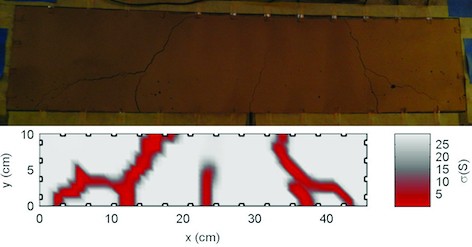‘The sensing skin could be used for a wide range of structures, but the impetus for the work was to help ensure the integrity of critical infrastructure such as nuclear waste storage facilities,’ said Dr Mohammad Pour-Ghaz, an assistant professor of civil, construction and environmental engineering at NC State and co-author of a paper describing the work.
‘The idea is to identify problems quickly so that they can be addressed before they become big problems and – in the case of some critical infrastructure – so that public safety measures can be implemented.’

According to NC State, the skin is an electrically conductive coat of paint that can be applied to new or existing structures. The paint can incorporate any number of conductive materials, such as copper, making it relatively inexpensive.
Electrodes are applied around the perimeter of a structure with the sensing skin then painted onto the structure, over the electrodes. A computer program then runs a small current between two of the electrodes at a time, cycling through a number of possible electrode combinations.
Every time the current runs between two electrodes, a computer monitors and records the electrical potential at all of the electrodes on the structure. This data is then used to calculate the sensing skin’s spatially distributed electrical conductivity. If the skin’s conductivity decreases, the structure has cracked or been otherwise damaged.
The researchers have developed a suite of algorithms that allow them to both register damage and to determine where the damage has taken place.
‘Determining the location of the damage based on the measured electrode potentials is a challenging mathematical problem,’ said Dr. Aku Seppänen, an Academy Research Fellow in the Department of Applied Physics at the University of Eastern Finland and co-author of the paper. ‘We had to develop new computational methods to more reliably determine where the damage is. Ultimately, I think our work represents an advance over previous algorithms in terms of accuracy.’
The researchers have reportedly demonstrated the effectiveness and accuracy of the sensing skin on a small scale, using concrete beams less than a metre wide.
‘Our next step is to extend this to large geometries,’ Pour-Ghaz said in a statement. ‘We want to show that this will work on real-world structures.’
The paper, ‘Electrical impedance tomography-based sensing skin for quantitative imaging of damage in concrete,’ was published in Smart Materials and Structures. The research was partly supported by the Academy of Finland.




Glasgow trial explores AR cues for autonomous road safety
They've ploughed into a few vulnerable road users in the past. Making that less likely will make it spectacularly easy to stop the traffic for...